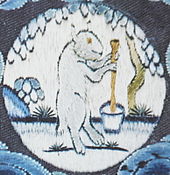Tsuki no Usagi
Tsuki no Usagi ( Japanese 月 の 兎 ; to German " Hare in the Moon " or "Hare on the Moon" or simply "Moon Hare") is a fictional creature of Japanese and Chinese mythology . In Japan, belief in the "moon hare" originates from the Shinto religion and refers to the legends "Of the fox, the monkey and the hare" and "The white hare of Inaba" ( 因 幡 の 白 兎 , Inaba no shirousagi ).
Lore
According to legend, a fox , a monkey and a hare were closely linked . While they played and hunted together in the mountains during the day, they spent the night together in the forest. The Lord of Heaven, Taishakuten ( 帝 釈 天 ), heard about it and found it unusual. Disguised as an old wanderer, he went to see the three friends. He found her by the campfire that evening and asked her for something to eat. The monkey immediately brought him nuts, the fox gave him a fish. But the hare found nothing to give the old man. When the monkey and the fox heaped abuse on the hare, the hare jumped desperately into the campfire and shouted: "Eat me!". The Lord of Heaven was so touched by the gesture that he restored the hare's body and took it to the moon , where it was buried in Taishakuten's temple. The smoke that the rabbit had created when it was sacrificed was reflected on the shiny surface of the moon and still imitates its shape today.
background

The background to the legend is the shadow of the moon, which is particularly easy to see when the moon is full . Their arrangement has always given people from the most diverse cultures cause for speculation about the origin and methods of formation of the moonspots. In addition, the spots of the moon stimulated people's imagination as to what shape could be seen in the spots. In Asia (especially China and Japan) people see a rabbit with a mortar or pounding tub. The phenomenon of supposed moon faces is called pareidolia .
In Japan, the rabbit prepares mochi dough in this pounding vat . This has its origin in a play on words, since “full moon” (where the rabbit is most visible ) means mochizuki ( 望月 ) in Japanese . This in turn sounds similar to mochi tsuki ( 餅 つ き ), the "Mochistampfen".
The moon hare in modern subculture
In today's subculture , especially in modern anime series such as Sailor Moon and Yu-Gi-Oh! , there are popular and widespread references to the moon hare. In Sailor Moon, for example, the heroine is called "Tsukino Usagi", which is based on the mythological rabbit of the same name. In Yu-Gi-Oh! the moon bunny appears as a card monster under the name “White Rabbit Inaba” , which attacks the opposing player by first jumping over the enemy monsters with his magic mortar and then jumping on the player's head.
literature
- Martina Schönbein: Seasons motifs in Japanese poetry: the canonization of kidai in the formative phase of Haikai in the 17th century. Otto Harrassowitz, Wiesbaden 2001, ISBN 3-447-04424-1 , p. 86.
- John A. Lent: Animation in Asia and the Pacific. John Libbey, New Barnets (UK) 2001, ISBN 1-86462-036-6 , pp. 35-38.
- Jürgen Blunck: How the devils blackened the moon. The moon in myths and legends. Spectrum Academic Publishing House; Heidelberg and Berlin 2003, ISBN 3-8274-1409-1 .
See also
Individual evidence
- ↑ Jan Westerhoff: Twelve Examples of Illusion . Oxford University Press, Oxford 2010, ISBN 978-0-19-538735-3 , pp. 28 ( limited preview in Google Book search).

